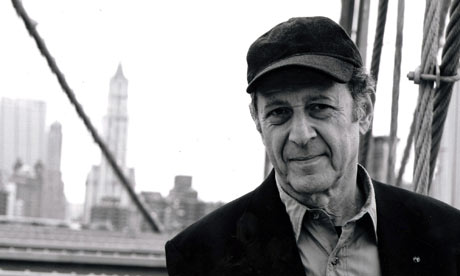I read an article by Kyle Gann about the birth of minimalism and its current place in music culture. He includes some comments from his personal experience, but he is allowed to because composers like Reich and Riley were just starting to gain momentum while he was in college! His whole relationship to minimalism has been heavily affected by the negative attitudes of the composition establishment; he was discouraged from attending a Reich ensemble concert in 1974, and even today he admits he is "marginalized in academic circles" for his enthusiasm for minimalism. I'd have to say I feel the same way after certain conversations with my composition professor...
 |
| A classic photo of Reich. Probably my favorite. |
Piano Phase is another piece with both musical and conceptual beauty. Any decent pianist can sit down and play the little phrase, and maybe get a friend to attempt the phasing part. I got to try this once with another pianist at a new music event in Brooklyn, during a downtime when people were just milling about. We didn't get very far, but it was fun to hear some of the sparkle once the parts slowly go out of phase. Another great thing about this piece is that it's pretty damn clear what's going on. The audience goes through the thought process of "Is this all there is too it? Oh, now it's phasing. Is that really going to hold our attention, though? Oh WOW. This is cool." There's also a sense of Beethovenian triumph here. Reich starts out with a simple little piano figure and achieves incredible, mind-altering effects by the end.
There's a video on YouTube of a guy playing both parts by himself. That is hardcore.
Now on to La Monte Young. I listened a to a good chunk of his opus The Well-Tuned Piano, and I'm somewhat conflicted about what I heard. The sounds are undeniably beautiful. Each note has a unique color and character. The minor intervals are profoundly plaintive, and the whole piece has a slow, languid beauty. But is it enough? Young's aim seems to be inducing a hypnotic state, but I've heard music in experimental tuning that strives for more structure and variety. Michael Harrison, a regular at the Bang On A Can Marathon, has an hour-long piano piece called Revelation in just intonation. He reveals the tones slowly and methodically, but it eventually grows into a piece of epic scope. Harrison has written a lot in this tuning system, and perhaps my favorite is Just Ancient Loops, for amplified cello and tape. It ends with the most spine-chillingly awesome chord I've ever heard (24:13). There is so much potential in just intonation, and I think it's only a matter of time before it sneaks its way into adventurous pop music. Seriously.
I listened to another La Monte Young piece, an excerpt from Map of 49's dream the two systems of eleven sets of galactic intervals... Aside from the brow-raising title, this piece is simply a high drone. The timbre of the drone changed slightly over the course of seven minutes, but that was it. I didn't mind it, but I also didn't really enjoy it.
Finally, I should mention Terry Riley, since In C is one of the very earliest minimalist pieces. This has even more of a communal vibe than Music For 18 Musicians, since the players have to keep listening to each other and judge when it's the right time to move from one phrase to the next. It's cool how the piece can be over in 5 minutes or 45. I prefer longer versions.
No comments:
Post a Comment